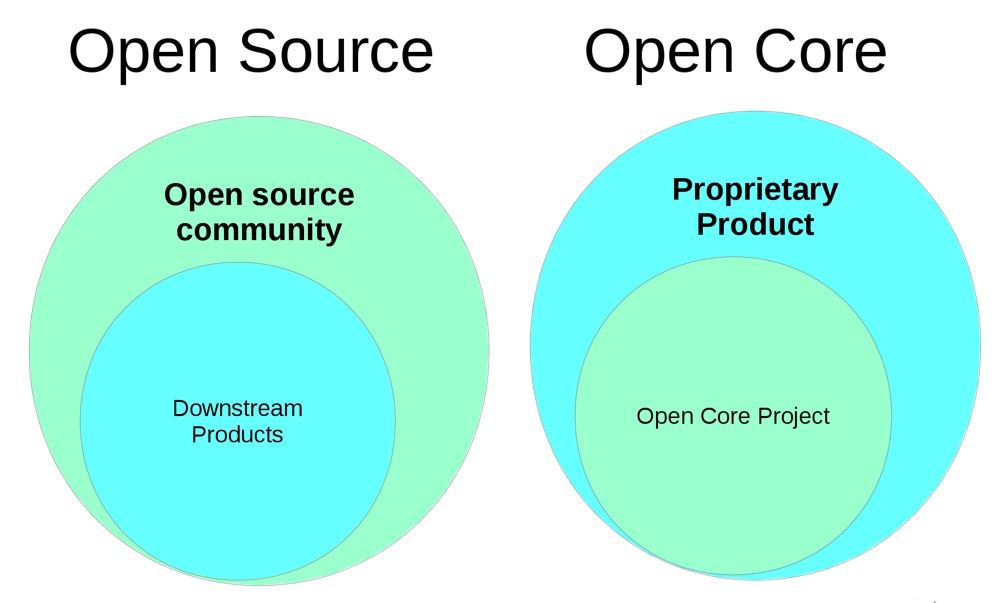John Mark Walker is the Open Source Ecosystems Manager at Red Hat.

I never thought I’d have to write this article in 2015. By now, I thought it would be self-evident how to derive revenue from open source software platforms. But alas, no. Despite the fact that the success of open source software is unparalleled and dominates the global software industry, there are still far too many startups repeating the same mistakes from a thousand startups past. And there are still far too many larger companies that simply don’t understand what it means to participate in, much less lead, an open source community.
It’s been nearly 17 years since “open source” was coined to replace the term of art, “free software” – deemed far too scary for the MBA-toting pointy-haired bosses among us:
“Freedom? Yech! Let’s use open source instead.”
Since then, every single area of innovation in computing is now dominated by the open source platforms among us. From operating systems, virtualization and containers to big data, cloud management, and mobile computing, chances are good that innovation is happening on an open source platform. So dominant is the breadth of open source ecosystems that virtually the entire world’s economy depends on open source software. I hesitate to think what would happen to the global economy should open source software be suddenly made inaccessible (think financial collapse and societal unrest on a biblical scale).
Despite this massive success, there is something missing from the world of open source: successful open source companies. We are now in a “Tale of Two Cities” type of story: It was the best of times, it was the worst of times. The most visibly “successful” open source startups from the last ten years are companies that were acquired by larger ones. These companies, while successfully attracting large communities of users and developers, were not sustainable, revenue-wise. There are a number of executives from open source-heavy software vendors who have openly remarked that it is impossible to create a successful business with a “pure” open source approach.
Open core model
Many companies have adopted a particular model around creating and selling open source software: create an open source platform or base and sell proprietary software that integrates with the underlying open source platform. In this case, the platform is always free or “Free” and the product they actually sell for revenue is proprietary. This model has been labeled “Open Core” – more on that, below, and is the way most VC-backed companies approach open source development.
In fact, there has only been one company (yet) to ever make a viable business model from selling only open source software: Red Hat. But is that the end of the story? Is it really as simple as “nobody can create another successful pure open source business?” I submit that those who agree with that statement are wrong. For one thing, the Open Core approach has never resulted in a successful product. The reason companies do this is that, in their opinion, this allows them to increase their profit margins and more quickly approach profitability. However, most of the value in this model is in the platform itself, and treating it as a worthless commodity while simultaneously trying to build proprietary software on top results in a cut-rate buyers market without the margins the vendors hoped for. Furthermore, this approach leads to a constant battle between “how much do we cripple the open source platform to enable more proprietary sales” and “how can we make the open source platform good enough to increase adoption but not too good.”
In fact, no proprietary product built as an addition on top of open source software has ever achieved ubiquity in the modern data center, with the possible exception of VMware, which utilized a stripped-down version of Linux for its ESX hypervisor. Even then, the Linux base for ESX was a pretty small part of the overall platform VMware built. It seems that the only successful products that utilize open source components are those where the proprietary bits *are* the platform, and the open source parts are simply the commodity bits that fill in the gaps that developers can use to more quickly create a product.
Risk-averse investors
And yet… purely open source systems are proliferating in every industry in every region of the world. The list of successful open source platforms grows every day. How does one follow the money? How is this even possible if vendors are right when they claim that they cannot build successful businesses with a pure open source approach? The problem is not that software vendors cannot make money selling open source products, but rather that the problem is misstated. For one, we are looking in the wrong places: software isn’t created only by software vendors anymore. There are consultants, systems integrators, in-house developers, cloud hosting providers and a host of other people who create, buy, sell and use open source products.
It is not that there is no money in selling open source software, but rather that the business models have shifted. Whereas, under the old proprietary world, a larger percentage of money went to pure software vendors, now that money has spread among a larger spectrum of companies and industries; lots of people get paid to work on or with open source software, but an increasing number of them don’t work for software vendors, per se. In addition to looking in all the wrong places, the current investment model is suspicious of an open source approach. The vast majority of venture capitalists, especially in Silicon Valley, are very risk averse and shy away from open source products that, in their view, will not give as large a return on their investment. In order to secure the funding required to scale a company, investors will frequently require that the startup company include proprietary bits as tools to increase revenue and margins. These two factors – diffusion of revenue and risk-averse investors – combine to both give a false impression and, in part due to the false impression, prevent pure open source software vendors from getting funding.
So is there a future in pure open source products? And if so, how can you capitalize on it? This is the first article in a series in which I will investigate many open source business models, some of which have been more successful than others. I’ll also go into some level of detail on how to productize software derived from open source projects. It’s both trickier and simpler than what you might imagine. Let me know what you think in the comments, and I’ll be sure to respond to your feedback in future articles.
Read Part 2: Open Core vs. Hybrid Business Models




